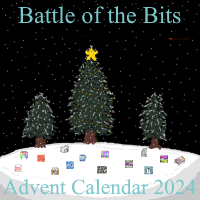::|CONTENTS
- Tools
- Restrictions on submit
- Renders
- ASCII table
The ASCII format is used for visual artwork made with text. The ASCII standard is as old as 1963, but text based art has been around since the late 19th century with the typewriter as a medium. Today, ASCII is frequently used as a catch-all term for all text based artwork on computers, though submissions in this format are limited to the 94 printable characters in the ASCII standard.
Tools
A basic text editor.
An ASCII table
Restrictions on submit
Submission should be a plain .txt file containing your ASCII art.
The ASCII format was historically also used for programming and creative writing battles, but due to a few unsavory incidents the format is now
strictly for visual art (though supplementary writing may be included). Bitmap-to-ASCII converters are also heavily discouraged unless used as one of several tools for a synthetic work.
Renders
A screenshot of your art in the text editor will suffice, and can be rendered in either white-on-black or black-on-white text + background.
ASCII table
Below are the 94 printable characters used in BotB ASCII battles including decimal/hex codes for ASCII character codes 32 - 127. Note 127 (the delete character) is excluded although it is technically "printable". ASCII characters 0 -31 are control characters and unprintable. ASCII battles do not included extended ASCII codes (128 - 255).
DEC
HEX
CHARACTER
32
20
<Space>
33
21
!
(exclamation)
34
22
"
(double quote)
35
23
#
(number sign)
36
24
$
(dollar sign)
37
25
%
(percent)
38
26
&
(ampersand)
39
27
'
(single quote)
40
28
(
(open parenthesis)
41
29
)
(close parenthesis)
42
2A
*
(asterisk)
43
2B
+
(plus)
44
2C
,
(comma)
45
2D
-
(hyphen)
46
2E
.
(period)
47
2F
/
(forward slash)
48
30
0
49
31
1
50
32
2
51
33
3
52
34
4
53
35
5
54
36
6
55
37
7
56
38
8
57
39
9
58
3A
:
(colon)
59
3B
;
(semicolon)
60
3C
<
(open angled bracket)
61
3D
=
(equals)
62
3E
>
(close angled bracket)
63
3F
?
(question mark)
64
40
@
(at symbol)
65
41
A
66
42
B
67
43
C
68
44
D
69
45
E
70
46
F
71
47
G
72
48
H
73
49
I
74
4A
J
75
4B
K
76
4C
L
77
4D
M
78
4E
N
79
4F
O
80
50
P
81
51
Q
82
52
R
83
53
S
84
54
T
85
55
U
86
56
V
87
57
W
88
58
X
89
59
Y
90
5A
Z
91
5B
[ (open bracket)
92
5C
\
(backslash)
93
5D
] (closing bracket)
94
5E
^
(caret)
95
5F
_
(underscore)
96
60
`
(grave accent)
97
61
a
98
62
b
99
63
c
100
64
d
101
65
e
102
66
f
103
67
g
104
68
h
105
69
i
106
6A
107
6B
k
108
6C
l
109
6D
m
110
6E
n
111
6F
o
112
70
p
113
71
q
114
72
r
115
73
s
116
74
t
117
75
u
118
76
v
119
77
w
120
78
x
121
79
y
122
7A
z
123
7B
{
(opening brace)
124
7C
|
(pipe / vertical bar)
125
7D
}
(closing brace)
126
7E
~
(tilde)
Fun fact: In Windows, you can use Alt + a number combination to manually type any character. For example, hold Alt and type "120". Releasing alt will type the ASCII "x" character which matches the decimal number code. Try typing weird longer codes outside of the standard ASCII character set like Alt + 0198 for finding those weird characters!
____________
|_.______.__||
| _||------|._||
| _||____|__||
|_. ______._||
|_||-------|_||
|_||-------|_||
|_||-------|_||
::::::::::::::::::::
____________
| __________||
| ||
| ||_________
|________ __||
------------|__||
________|__||
|__________||
::::::::::::::::::::
___________
| _______|_|
| ||
| ||
| ||
| ||
| ||__________
|__________|_|
:::::::::::::::::::::
_____________
|____ ____|_|
-------| ||
-------| ||
-------| ||
-------| ||
-____| ||_____
|__________|_|
::::::::::::::::::::::
_____________
|____ ____|_|
-------| ||
-------| ||
-------| ||
-------| ||
-____| ||_____
|__________|_|
::::::::::::::::::::::


